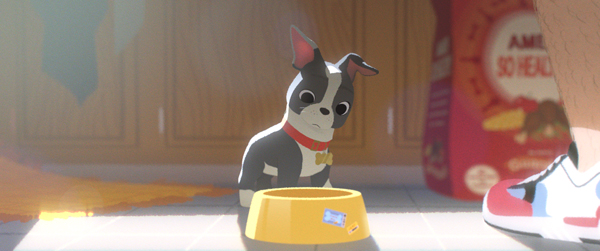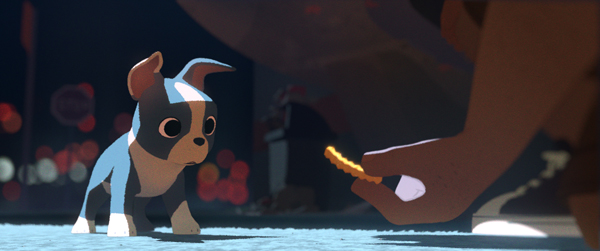 One of five animated shorts nominated for an Academy Award, Feast is the first film directed by Patrick Osborne. An animator who has worked on Disney features like Bolt and Tangled, Osborne received approval for Feast on the basis of a pitch he gave to the shorts program at Walt Disney Animation Studio.
One of five animated shorts nominated for an Academy Award, Feast is the first film directed by Patrick Osborne. An animator who has worked on Disney features like Bolt and Tangled, Osborne received approval for Feast on the basis of a pitch he gave to the shorts program at Walt Disney Animation Studio.
Last week Osborne was in New York City to promote Feast. We talked at a midtown Manhattan Disney office. The bulk of the interview appears on the Film Journal website. Osborne is soft-spoken and very articulate, and given the chance he’s also pretty funny. I’ve included some extra material here.
On first seeing the finished Feast
I wasn’t too like “crazy theater experience person” before this, but now I am. Because I see all the variations and all the choices you make. You make them for the theater, you’re making them for when you’re sitting there. So to see it other ways, okay, it works, but it’s really great to see something in the theater.
The first time I really got to see the movie finished with an audience, the audience was an orchestra. Last year in May we went to the Warner Bros. Soundstage with thirty musicians for one morning. We only had a couple of hours to get the whole score recorded. We showed the musicians what they were going to be playing [to], and that was super emotional for me because you realize you don’t even know how you got here at this point. How did I end up seeing my own movie with people playing live? You have to be very silent but it’s really neat to sit there and watch [soundtrack composer] Alex Ebert , someone like that in his element, like really craft something he loves, see it go from not there to something that he was proud of.
Is Feast for kids or adults?
Well, a little kid can watch the dog and enjoy the short in that way. A more mature audience can enjoy it in other ways.
When we finally showed it to kids … You know as you’re making the movie you forget that, oh, kids are going to see this. You show it to a lot of your coworkers, and at film festivals it’s all animators and they’re adults or film fans.
But Telluride we showed it to all of the kids in the town, kindergarten through sixth grade, in a 900-seat auditorium. They reacted to totally different things than an adult audience reacts. They laughed the whole time. It’s a way better response than any adult audience ever gives.
They were talking back to the screen, “Why is he sad?” It makes me want more of a kid audience early on just to realize what is clear and what’s not. Because they’ll start asking questions out loud, in the moment , when the question is necessary.
Afterwards we did a Q&A with them. Because of the lighting, we couldn’t see the back, we couldn’t see past the first few rows. So the only people who got to ask questions were the kindergarteners, who couldn’t even touch the ground in their seats.
And they raised their hands and they’re like, “My dog just died.” What am I supposed to say? And one kid’s like, “How much money do you make?” I said, “It’s more than a hundred dollars.” She said, “Is that enough to start a family?”
I wanted this to look very graphic and designed. Every frame of animation is handmade, although it’s not as obvious all the time like it used to be.
I went back and watched all of Disney’s dog stuff, all the shorts and Lady and the Tramp and 101 Dalmatians to make sure that there weren’t any Boston Terriers in them. And then we put a spaghetti and meatballs shot in the credits just to kind of pay homage to Lady and the Tramp.
I wanted to set Feast in the dog’s world, but I wanted adults watching to be able to feel the human background behind it. Hopefully it kind of like grazes over you a little bit.
You know, you want the emotional climax to happen at the same time as the dog is kind of realizing something has changed and I think it does work that way. It’s close to working that way. The audience is slightly ahead of the movie at one part. You kind of figure it out a few seconds before it’s shown to you. That ten seconds of anticipation is really fun, and I think that’s where the emotion comes from.
Winston’s story is like a sacrifice. Sometimes you make a sacrifice not realizing what the reward’s going to be, you can be rewarded in ways you don’t expect. You don’t realize that’s what you’re making necessarily in the beginning. And then you as you work, it starts to emerge, “Oh, that’s the theme.”



